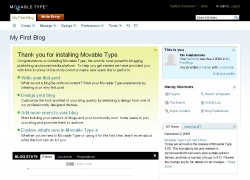Movable Type
Movable Type is a commercial offering, turned open source from Six Apart. It is billed as both a blogging system as well as a simple content management system. It can manage multiple websites/blogs with one install. There is a free blogging version, and then business and enterprise versions that cost much more.
Current Version: 4.25
Cost: Free, $395, $1,499
Development: Commercial, Community
Specialization: Blog
Hosting: Own Server, Subscription hosting
Source: Open Source
License: GNU GPL
Language: PHP, Perl
Database: MySQL, PostgreSQL, SQLite
Our Experience:
Movable Type has a great interface that makes blogging easy. One of the most unique things about it is that it is built to handle multiple blogs/sites, and each one can have unique settings and templates. It’s easy to publish content in either entry or page form, and add custom fields as you go.
Being both a commerical and open source CMS you get the advantages and disadvantages of both sides. You can know that it is pretty safe to use it on a client project because there will be support for it in the future. But the price to use it for a business level gets high, especially for 20 authors!
Helpful Links:
- MovableType.org The home page for designers/developers who want to research the system.
- MovableType.com For clients and others who want to know more about blogging and MovableType.
- Suggest a Link
Related Site News:
User Reviews: Submit Your Own
You must be logged in to post a comment.





Strengths: For the sake of brevity, here are some of the things that Movable Type gets very right:
-It uses an object-relational mapper system similar to Hibernate for Java for accessing the database in most cases (you can still run raw SQL when you actually need it).
-It uses a database-agnostic driver system, which allows it to support virtually every major database you might have to use from MySQL, to Oracle.
-It “eats its own dog food.” The entire CMS is written using the same fundamental technologies that are used to build your blog. That’s how powerful the template system and the code that supports it is.
-It can seamlessly manage multiple web sites, though the CGI scripts do (as of 4.25) point to the domain specified as the CGIPath in the configuration file, which does somewhat limit.
-It has very robust user management, and it can authenticate against an insane number of sources ranging from OpenID, to LDAP, to Apache BasicAuth.
-SixApart, its corporate owner, has put a lot of serious engineering into it.
-Making new templates is very fast, and can be done with very little technical knowledge using the built-in tools. Designers don’t have to be developers
Weaknesses: Performance is the main technical issue that Movable Type has. It is, quite frankly, too big now to be used on a shared host. It has started to outgrow this market in a real way, and there are limits to how fast you can make it run in a shared hosting environment because it is run as a CGI script, whereas PHP-based solutions get to run as web server modules. In a corporate environment, it would make an outstanding CMS because of the resources that could be brought to bear on it; complaining about its poor performance in a shared hosting environment is as unfair to it in some ways as would be complaining about Oracle DB in a similar environment.
Community is a serious problem. There are not many contributors to Movable Type from a community perspective, and this is because SixApart seriously screwed the pooch with a business decision they made a few years ago with version 3.X. By trying to commercialize Movable Type back then, they enraged a significant portion of the bloggers who used it, and there is still incredibly negative feelings toward SixApart over that, despite the efforts of some of their engineers and new management to rebuild relations with their former users. As a result, there is a lot of inertia working against Movable Type, and new users will have a hard time finding much in the way of up-to-date themes, resources and technical help. The upshot of this, if there is one, is that most of the plugin developers who are left and contributing tend to be software engineers, and thus tend to write higher quality, safer code than is common with WordPress and other, more popular platforms.
There is one other area of potential weakness, and that’s the lack of authentication and authorization for actually viewing content. By default, Movable Type provides no support for even password restricting access to entries. This can be implemented using the Custom Fields feature, but users should not have to do this. The usual arguments for why this is the case are that it’d be hard to do right, but ultimately, what they’re really saying is that it’s fine and dandy to let the perfect be the enemy of the good.